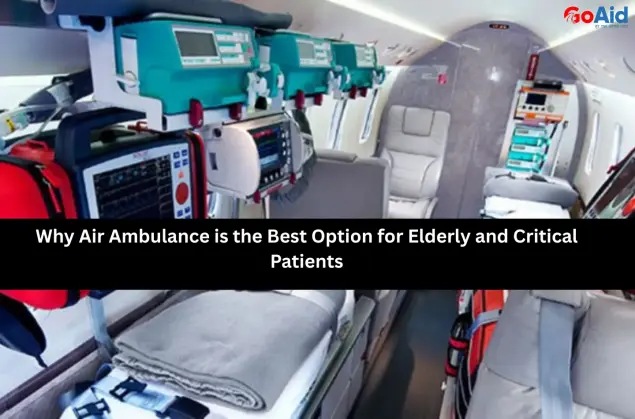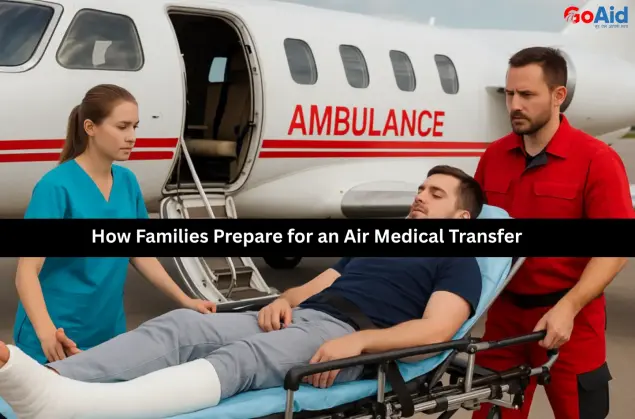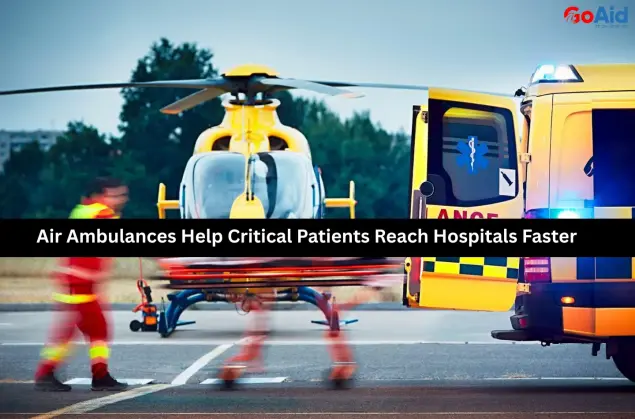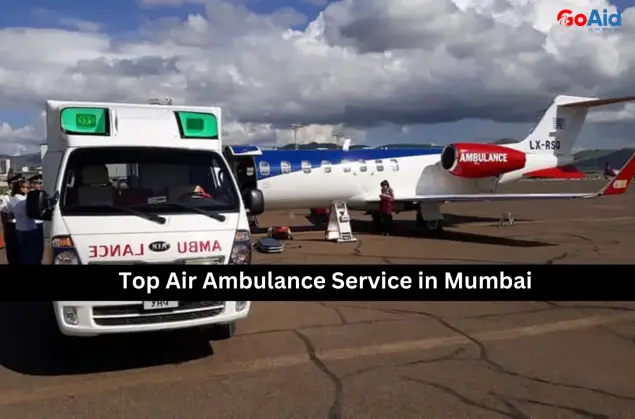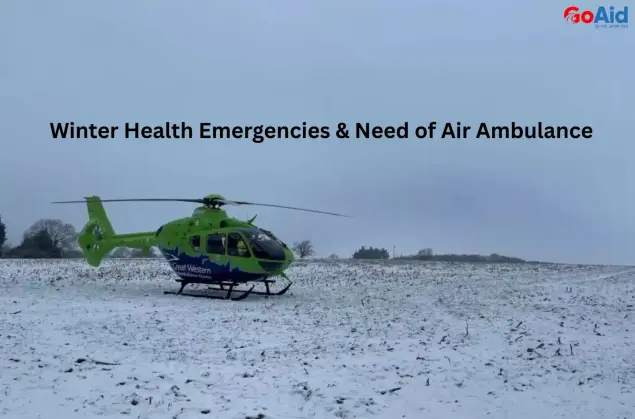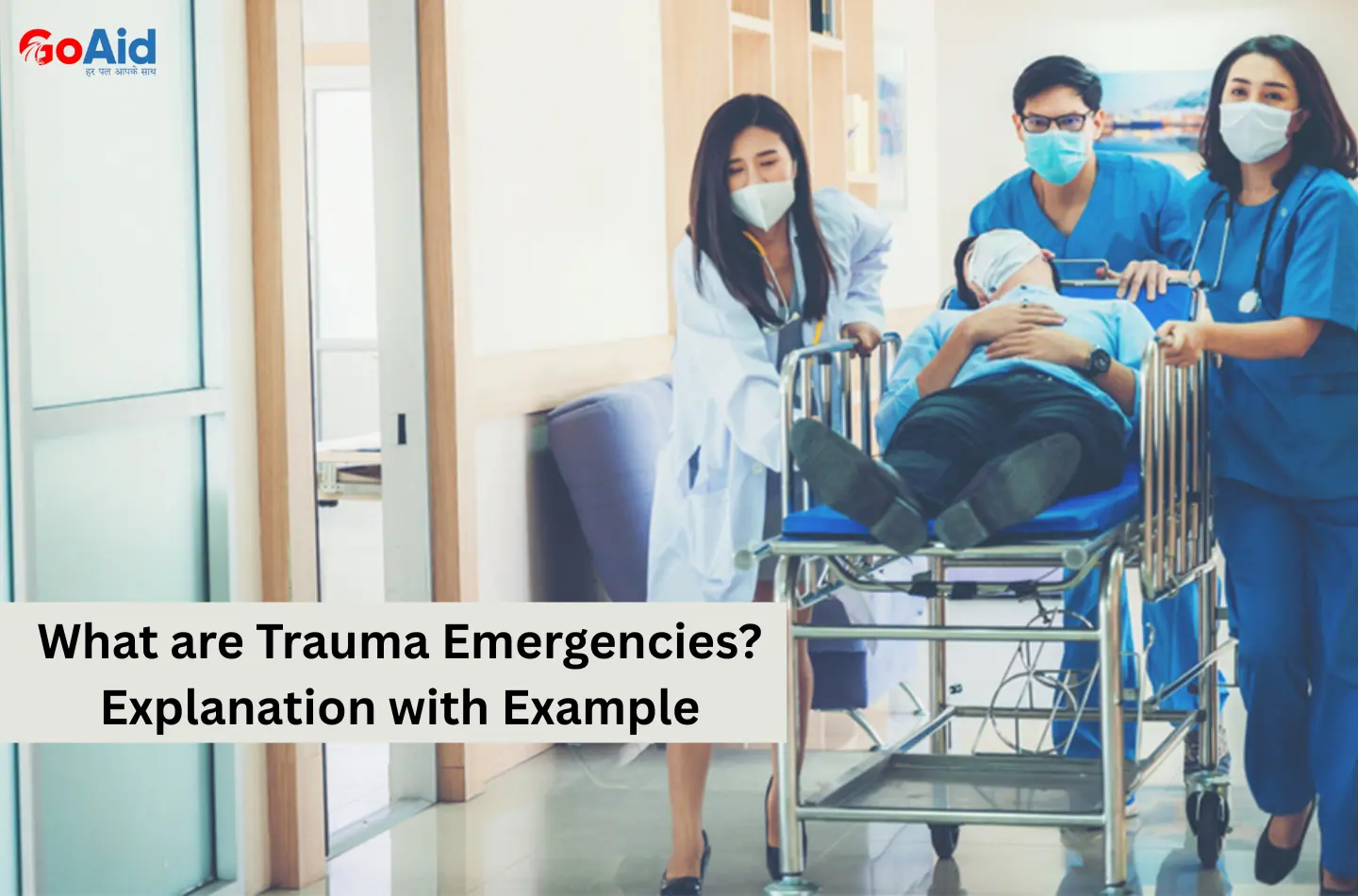
What are Trauma Emergencies? Explanation with Example
Trauma emergencies refer to severe, life-threatening injuries caused by sudden accidents, falls, collisions, or natural disasters that require immediate medical attention.
These situations often involve multiple injuries, internal bleeding, fractures, head injuries, or respiratory distress, where delays in treatment can lead to permanent disability or death. Rapid assessment, stabilization, and transfer to a specialized medical facility are crucial for survival.
Trauma emergencies demand swift action, advanced medical support, and continuous monitoring to prevent deterioration. Air ambulances play a pivotal role in such scenarios by offering fast, safe, and equipped transport. This ensures patients reach expert care without losing critical time.
Example
A road accident victim with multiple fractures and internal bleeding needs urgent ICU care. Using GoAid Trauma Ambulance, the patient was stabilized on-site, airlifted within 10 minutes, and safely transferred to a hospital with advanced trauma facilities, drastically improving survival chances and recovery outcomes.
Importance of Fast Medical Intervention in Trauma Emergencies
In trauma emergencies, every second counts. Delays in medical intervention can worsen injuries, increase the risk of complications, or even result in fatalities.
Fast medical attention ensures bleeding is controlled, fractures are immobilized, airway and breathing are supported, and vital signs are stabilized. Early intervention significantly improves survival rates, reduces long-term disability, and enhances recovery outcomes.
Emergency trauma care involves rapid assessment, timely resuscitation, and immediate transport to specialized hospitals equipped with ICU and surgical facilities. Air ambulances, like GoAid Trauma Ambulance, provide a critical advantage in such cases.
This offers rapid, safe transfer for accident patients or severe trauma victims. With ventilator support, life-saving equipment, and expert paramedics on board, patients receive continuous care en route.
Fast medical intervention bridges the gap between accident site and advanced hospital treatment, saving lives across India by ensuring trauma patients receive timely, expert care when every minute truly matters.
How GoAid Air Ambulance Handles Trauma Cases
GoAid Air Ambulance ensures swift, safe, and advanced trauma patient transfers across India. This provides life-saving care with ICU support, ventilators, expert paramedics, and continuous monitoring during emergencies.
- Rapid Response: GoAid responds within 10 minutes of booking, minimizing delays in reaching trauma victims, crucial for survival during severe accidents or critical emergencies.
- Advanced Ambulance Fleet: Equipped with ICU, ventilators, monitors, and trauma kits, each ambulance ensures high-level care for patients en route.
- On-Site Stabilization: Paramedics provide immediate medical care at the accident site, controlling bleeding, securing airways, and stabilizing vital signs before transport.
- Continuous Monitoring: Patients are constantly monitored for blood pressure, oxygen levels, heart rate, and other critical parameters during the air transfer.
- Safe Air Transfer: GoAid offers well-equipped aircraft for trauma patients, maintaining stable conditions during domestic or interstate transfers.
- Coordination with Hospitals: The team liaises with receiving hospitals to ensure ICU readiness and surgical support upon arrival.
- Specialized Trauma Equipment: Ambulances carry defibrillators, oxygen support, ventilators, and advanced life-support systems for all critical trauma emergencies.
Know More: Air Ambulance for Organ Transport: Speed That Saves Lives
ICU and Life-Support Facilities for Trauma Patients
GoAid Air Ambulance ensures trauma patients receive ICU-level care even during air transfers. Each aircraft is equipped with advanced life-support systems, including ventilators, defibrillators, oxygen therapy, suction devices, and cardiac monitors.
These facilities allow continuous monitoring of critical parameters like heart rate, blood pressure, and oxygen saturation. Specialized equipment for trauma, such as splints, immobilizers, and infusion pumps, ensures immediate intervention when necessary.
Life-support capabilities extend to pediatric and adult patients, catering to complex medical needs. Onboard paramedics can perform emergency procedures, administer medications, and manage airway complications.
This high-level care reduces complications, prevents deterioration, and ensures patients reach hospitals in stable condition, bridging the gap between accident sites and specialized trauma centers effectively.
Role of Trained Paramedics in Critical Cases
Trained paramedics are vital in trauma emergencies. This provides expert on-site care, stabilization, and continuous monitoring during air transfers, significantly increasing patient survival and recovery chances.
- Rapid Assessment
Paramedics quickly evaluate the patient’s condition, identifying life-threatening injuries and prioritizing interventions for faster, effective trauma care.
- Airway Management
They secure and maintain open airways, preventing respiratory failure in critically injured patients.
- Bleeding Control
Immediate control of external bleeding using pressure, bandages, and splints reduces the risk of shock and complications.
- Cardiac Support
Paramedics monitor heart functions, administer medications, and use defibrillators when needed to stabilize patients.
- Ventilator Operation
Trained staff manage ventilators during air transfers for patients with breathing difficulties or critical respiratory conditions.
- IV and Medication Administration
They administer fluids, medications, and pain relief accurately to maintain stability.
- Patient Monitoring
Continuous tracking of vital signs ensures timely intervention if conditions worsen mid-transfer.
- On-Site Emergency Procedures
Paramedics perform emergency interventions like CPR or trauma resuscitation at the accident site.
- Coordination with Doctors
They communicate with hospital teams to prepare ICU readiness before patient arrival.
- Emotional Support
Paramedics provide reassurance to patients and families. This reduces panic and aids smoother transfers.
How GoAid’s 10-Minute Response Time Saves Lives in Trauma Emergencies
In trauma emergencies, every second counts. GoAid Air Ambulance’s 10-minute response ensures rapid deployment to accident sites, minimizing delays in critical care. Quick arrival allows paramedics to stabilize patients immediately, control bleeding, manage airways, and begin life-saving interventions.
Early access to ICU-equipped ambulances prevents complications like shock, organ failure, or cardiac arrest. Rapid transfer to specialized trauma centers ensures patients receive advanced surgical care and continuous monitoring without waiting.
This fast response significantly improves survival rates and reduces the risk of permanent disabilities. By bridging the gap between accident locations and hospital care, GoAid’s rapid response system provides timely, expert, and life-saving support during high-risk trauma emergencies across India.
What does GoAid Do for Patient Stabilization During Air Transfer?
GoAid Air Ambulance ensures trauma patients remain stable during air transfers through comprehensive medical support. Experienced paramedics continuously monitor vital signs, including blood pressure, oxygen levels, and heart rate, adjusting care as needed.
Onboard ICU equipment, ventilators, infusion pumps, and cardiac monitors allow immediate intervention for complications. Patients receive airway management, bleeding control, medication, and pain relief during transit. Life-support systems handle respiratory or cardiac emergencies effectively.
Paramedics also immobilize fractures, provide oxygen therapy, and maintain patient comfort. Coordination with the receiving hospital ensures readiness for immediate treatment upon arrival.
This combination of advanced equipment, expert care, and continuous monitoring bridges critical time gaps. This ensures trauma patients reach specialized hospitals safely and in optimal condition.
Domestic vs International Trauma Transfers
Domestic trauma transfers involve moving patients between cities or states within India using ICU-equipped air ambulances. GoAid ensures rapid, safe, and fully monitored transport for accident victims or critically injured patients, covering all major locations like Delhi, Mumbai, Kolkata, and Patna.
Transfers include continuous care with ventilators, defibrillators, and life-support systems, with trained paramedics onboard. Domestic transfers prioritize speed, stabilization, and coordination with hospitals for immediate treatment.
International trauma transfers involve transporting patients across countries, often requiring additional documentation, customs clearance, and specialized aircraft capable of long-distance flights. GoAid manages international transfers with professional coordination, medical escorts, and communication with foreign hospitals.
This ensures patients receive continuous ICU care during travel. Both services focus on patient safety, fast response, and advanced medical support, but international transfers require meticulous planning, cross-border permissions, and longer flight coordination.
GoAid’s experience ensures seamless transfers for trauma patients. This provides life-saving care in both domestic and global emergencies.
Also Read: Air Ambulance Providers in India
Tips for Families During Trauma Emergencies
During trauma emergencies, families play a vital role in ensuring patient safety. Staying calm, acting quickly, and coordinating with medical services can make a life-saving difference for critically injured patients.
- Stay Calm: Panic can worsen the situation. Take deep breaths, focus on immediate needs, and communicate clearly with emergency responders.
- Call Emergency Services: Contact GoAid Air Ambulance or local medical helpline immediately to ensure rapid professional assistance.
- Provide Clear Information: Share accident details, injuries, patient age, and location accurately for faster response and proper preparation.
- Follow Instructions: Listen to paramedics or call-center guidance on handling the patient before professional help arrives.
- Avoid Moving the Patient: Unless necessary, keep the patient still to prevent worsening fractures or spinal injuries.
- Monitor Vital Signs: Observe breathing, pulse, and consciousness, informing paramedics of any changes.
- Prepare Documents: Keep ID, medical history, and insurance ready for faster hospital admission and treatment.
- Ensure Safety at Site: Remove hazards around the patient to avoid further accidents.
- Provide Emotional Support: Calm and reassure the patient. This reduces stress and shock during emergency care.
- Stay Updated: Maintain communication with medical teams for updates on patient condition and transfer progress.
Conclusion
In conclusion, trauma cases demand immediate medical attention, and GoAid Air Ambulance provides a reliable, fast, and advanced solution. From 10-minute response times and expert paramedics to ICU-equipped aircraft and life-support systems, GoAid ensures patient safety during critical emergencies.
Families can play a supportive role by staying calm. This provides information, and coordinating with medical teams. By combining professional care with timely intervention, GoAid saves lives, reduces complications, and ensures trauma patients reach specialized hospitals quickly and safely across India.
FAQs
Q1: What makes GoAid Trauma Ambulance the best choice for trauma emergencies?
A: GoAid offers 10-minute response time, ICU-equipped air ambulances, expert paramedics, ventilator support, and nationwide coverage. This ensures rapid, safe, and life-saving transport for trauma patients.
Q2: Can GoAid handle severe trauma patients with multiple injuries?
A: Yes, GoAid’s ambulances carry advanced life-support systems, trauma kits, ventilators, and trained paramedics capable of stabilizing patients with multiple fractures, head injuries, or internal bleeding during transfers.
Q3: How quickly can GoAid reach accident sites in major cities?
A: GoAid Air Ambulance reaches most locations within 10 minutes of booking. This provides rapid assessment, stabilization, and transfer to specialized trauma hospitals, saving precious time in critical emergencies.
Q4: Are GoAid services available for international trauma patient transfers?
A: Yes, GoAid manages international transfers with specialized aircraft, medical escorts, cross-border coordination, and continuous ICU care. This ensures trauma patients receive safe, uninterrupted treatment during long-distance flights.
Q5: What should families do while waiting for the ambulance?
A: Families should stay calm, monitor vital signs, provide accurate accident information, avoid moving the patient unnecessarily, and follow paramedic instructions to ensure safety until professional help arrives.
